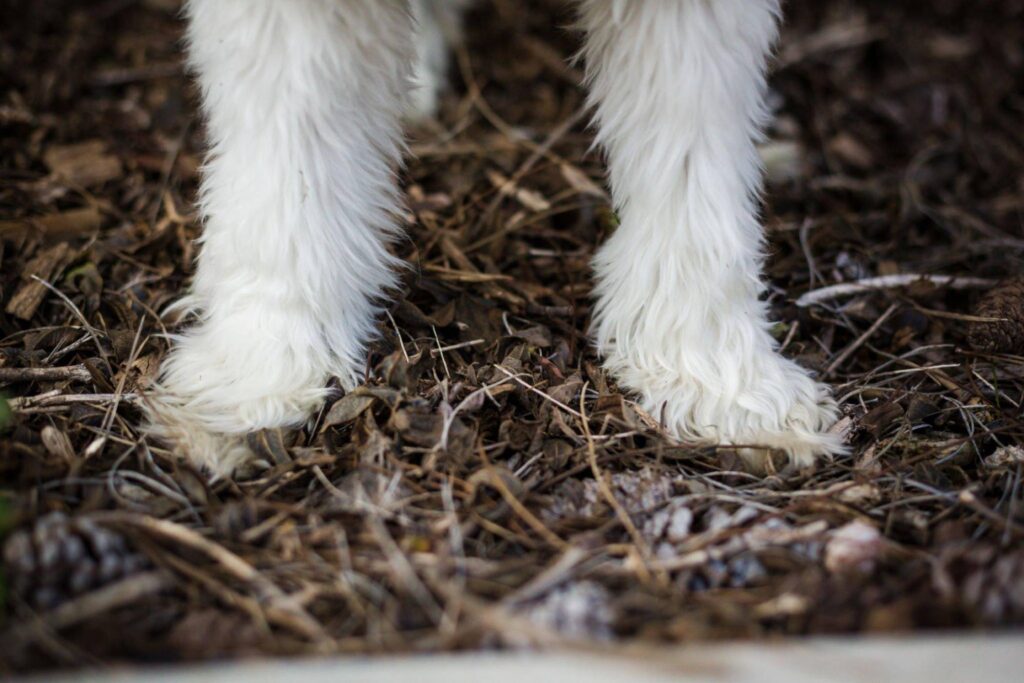Last Updated on 9 months ago by Nicky Johnson
How to fix east-west feet in dogs? It is mainly asked by the people with dogs who face the issue of forward pointing feet. These feet are called east-west feet in dogs or pigeon toes.
It is a weird problem in dogs, and if the condition is not treated correctly, they may feel discomfort, decreased mobility, and joint issues.
But the good thing is that you can fix east-west feet in dogs by using suitable approaches. You can fix east-west feet problem and relieve your dog from the pain and discomfort he is bearing due to east-west feet.
You can prevent east-west feet by feeding your dog a balanced diet, physical exercise, and avoiding the things that develop east-west feet or carpal valgus.

What is East West Feet in Dogs?
Blog Contents
If we talk about the average dog’s standing position, it stands straight with its feet pointing straight. A dog’s resting standing posture is an excellent indicator of its general health.
At the same time, the dog has east-west feet and doesn’t have straightforward pointing feet. Such dogs usually have small or medium height with shorter legs.
They’re called small dogs. They also include dogs with long nails, dogs of average size, and dogs of heavy weight.
They have small physical stature. There are also dogs with long backs. The dog may have a disability that leads to east-west feet syndrome. Some dogs have paws turn outwards. Some dogs are born with medial patellar luxation.
There is no specific reason that cause east-west feet issue. Australian Terriers and Dachshunds are the more vulnerable that suffer from the condition known as east-west feet. This problem is only limited to this breed; they express the issues when they are pups.
It is a problem of posture such as feet pointing forward and health, so you can help your dog get the proper position with some help.
What Causes of East West Feet in Dogs?
The exact cause or reason of east-west feet is unknown. A few factors in dogs may also be considered as the reason behind the east-west trauma.
Genetics
Some dogs may be predisposed to having East-West feet due to their breed or genetic makeup. Certain breeds, such as Bulldogs, Basset Hounds, and Dachshunds, are more prone to having this condition. These breeds have a genetic defect that affects bone growth.
The effect type may differ, such as certain dog breeds have uneven front legs, slight paw deformities, twisting front toes, and weak pasterns. They can’t keep their feet flat on the ground.
Growth Abnormalities
Rapid growth during puppyhood can sometimes lead to East-West feet. When the bones and joints develop too quickly, they may not align properly, resulting in-toeing in or out.
When growth abnormalities occur, the bones may not align properly, leading to an imbalance in the muscles and ligaments that support the feet.
This imbalance can cause the toes to splay outwards, resulting in the east-west feet appearance. If you have large dog breeds, your dog will develop paws outward instead of straight due to growth abnormalities.
Muscle Imbalances
if you have noticed that your dog’s feet are pointing in opposite direction then, it may occur due to weak muscles. Weak or imbalanced leg muscles can cause dogs to walk with their feet turned inward or outward.
In most cases of east-west feet problems, smaller dogs have turned-out feet. It can be due to muscle weakness, injury, or neurological conditions.
Joint or Bone Abnormalities
joint health in dogs must be good and fit. In most cases, this problem occurs due to bone abnormalities. Bone abnormalities cause the feet to turn outwards.
Conditions like hip dysplasia or luxating patella (dislocated kneecap) can affect the alignment of the leg bones, leading to East or West feet. Fatty dog breeds are more prone to dog’s feet turn abnormal instead of paws flat on the ground.
Injury or trauma
Any injury or trauma to the legs or joints can disrupt normal alignment and cause dogs to develop East-West feet.
Sometimes, when puppies and young dogs jump from the upper surface or in hard places, dog’s front feet get injured, and their paws or legs slip.
The dog’s nails are also damaged in this incident. These are also the causes of your dog’s east-west feet.
Poor nutrition or an improper diet during a dog’s growth phase can impact bone and muscle development, potentially leading to abnormal foot positioning.
If you notice that your dog has East or West feet, it is essential to consult with a veterinarian. They can evaluate your dog’s condition, determine the underlying cause, and recommend appropriate treatment options.
Diet Issue
Let’s talk about another reason why your dog has feet turn outward, this is the diet for your dog. Make sure your dog gets an improper diet and is more prone to developing east-west feet.
If your dog is overweight, or you have a dog that overeats then it is a sign that your dog is getting east west paws condition that affects dogs.
How to Fix East-West Feet in Dogs?
There are many ways to fix cases of east west feet and they are considered the most effective in correcting the east-west feet syndrome.
Here is a comprehensive guide for care of a dog that will help the dog owners to correct east west feet point outwards. They are beneficial for dogs to avoid the problems common in dogs.
Early Detection
The earlier you identify the presence of east-west feet in your dog, the better your chance of correcting it. Regularly examine your dog’s paws and observe their gait.
Take your dog to the vet regularly. If you notice any abnormalities, consult a veterinarian or a professional dog trainer for a proper diagnosis.
Because it is necessary to correct the problem. The vet will help your dog maintain a good health.
Veterinary Guidance
If your dog has developed an east-west feet issue, then it’s essential to visit the vet or search for a nearby animal clinic. Consulting with a veterinarian is crucial in determining the underlying cause of the east-west foot condition.
They can assess your dog’s overall health, conduct a physical examination, and diagnose accurately.
He will provide your dog with the necessary treatment, some common causes of east-west feet in dogs include genetic factors, improper nutrition, injuries, or weakness in the ligaments and tendons. You can prevent east-west feet problems with the help of the vet easily.
Exercise And Physical Therapy
Regular exercise and targeted physical therapy are effective in correcting east-west feet in dogs.
Engage your dog in activities that encourage proper alignment, such as walking on uneven surfaces, using balance boards, or navigating through obstacle courses.
It will prevent east-west feet issues It will help your dog to get straight legs and feet to look like normal dogs. These exercises help strengthen the muscles and ligaments in the paws, encouraging correct positioning.
Weight Management
Maintaining a healthy weight is crucial for dogs with east-west feet. Excess weight can put additional strain on the joints, exacerbating the condition. It will cause your dog likely to develop east-west legs.
Consult your veterinarian to develop a suitable diet and exercise plan to achieve and maintain a healthy weight for the dog.
Dogs with an average weight are less prone to this syndrome as compared to overweight dogs.
If your dog is overweight or your dog is limping then prevent your dog from this syndrome. You can do so by feeding your dog a balanced diet. It will cause the feet to look like normal dogs.
Bracing Or Splinting
In severe cases of east-west feet, your veterinarian may recommend braces or splints. These devices are necessary to correct paws and encourage proper alignment.
It is essential to follow your veterinarian’s instructions regarding the duration and frequency of braces or splints and monitor your dog’s comfort and progress.
Nutritional Support
Proper nutrition is vital in maintaining your dog’s overall health, including bone and joint development. Consult your veterinarian to ensure your dog receives a balanced diet rich in calcium, phosphorus, and vitamins.
Nutritional supplements may also be recommended to support healthy bone and joint growth.
Beyond standard nutrition, joint supplements for dogs play a crucial role in promoting overall well-being. These supplements are carefully formulated to support healthy bone and joint growth, helping dogs maintain their mobility and comfort as they age.
It may be necessary to correct the syndrome in dogs. With a good diet, the dog maintains a healthy weight. it will be able to walk flat on any surface. His feet will not grow forward and outward abnormally.
Massage And Stretching
Regular massage and stretching can improve your dog’s paws’ flexibility and range of motion. Gently massage the muscles and ligaments around the affected area, and perform stretches to encourage proper alignment.
However, it is essential to learn these techniques from a professional to avoid causing any harm to your dog.
Assistive Devices
In some instances, assistive devices such as orthopedic shoes or boots can provide additional support and correct the alignment of the paws. These devices provide stability, comfort, and protection to the affected areas.
Consult with your veterinarian or a canine orthopedic specialist to determine whether these devices suit your dog’s condition.
Corrective Surgery
In severe cases where other methods have not been successful, corrective surgery may be an option. This should be discussed with a veterinarian who specializes in orthopedic procedures. Surgery may involve realigning bones or repairing ligaments to correct the east-west feet.
Regular Monitoring
To keep your dogs healthy and fit, remember to monitor them regularly. Continuously monitor your dog’s progress and adjust the treatment plan accordingly. Regular follow-up visits with your veterinarian are essential to assess the improvement and modify the treatment approach.
Genetic Considerations
If the east-west feet are due to genetic factors, consulting with a reputable breeder or genetic specialist is essential. They can guide breeding practices to avoid passing on this trait to future generations.

Conclusion
In conclusion, correcting east-west feet in dogs requires a combination of veterinary consultation, physical therapy, supportive devices, and a holistic approach to overall health.
The right interventions and consistent care can improve your dog’s gait and enhance their quality of life.
Remember to work closely with your veterinarian to develop a customized treatment plan that suits your dog’s needs.







